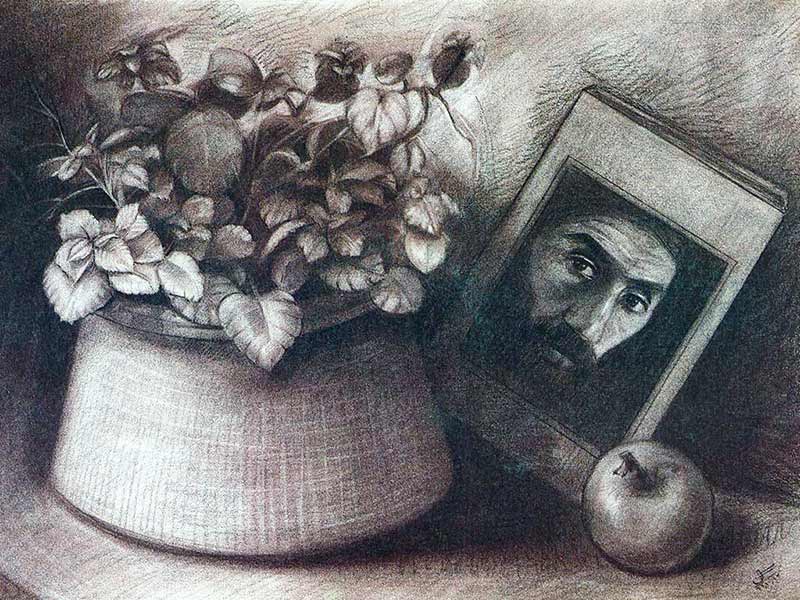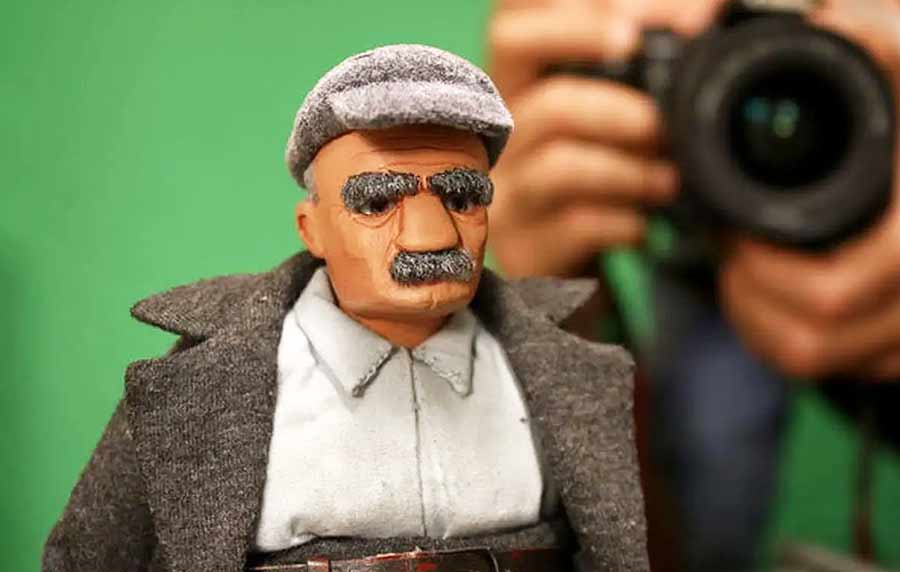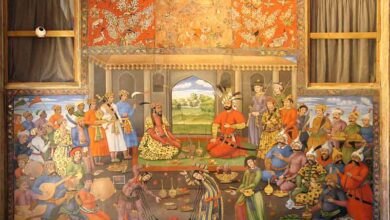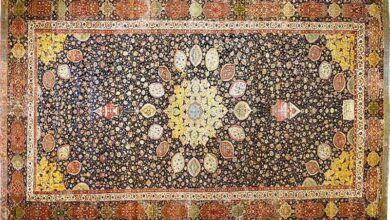Look at the paintings of Sohrab Sepehri

In the beginning, Sepehri’s reputation as a painter was more than his poetic reputation. This goes back to the 1950s. Although his poems were read in those years, they were not considered successful experiences except in terms of properties.
During these years, poetry was broken and epics gained more fans. Poets abounded in those days, and few painters, more than one mediocre painter, could record themselves in the collective memory.
Sepehri began his serious career as a painter with a series of illustrated and summarized images of nature. His earliest watercolors and gouaches can be considered as representations of moments of poetic experience in the world of objects. The free and accelerated movement of the brush, in all the color of the material, the emphasis on color contrasts and the use of focusing factors in two-dimensional space (for example, a red color is a sign of a fiery tulip) are among the characteristics of his works. And show the influence of the abstract painting of the Paris School. However, there is also a conscious effort to blend Eastern and Western traditions and an effort to achieve an independent and personal style.
The main theme of Sepehri’s work is the simplified forms of nature. Even a straight line. This is the simplest means of expression in painting – often in Sepehri’s works – drawn in such a way as to recall the vastness of the desert or the direction of a tree facing the sky. The remote mountains in central Iran, wherever we go, are at the bottom of the landscape. The wavy hills, which are closer to the mountains, the path of the river, which cuts the slope of the hill and carries a train of willow trees to the settlement, the houses attached to the settlement. The arched roof of the house is a corner of the door and the wall of the house in relation to the branch of a tree, the trunk of the tree, its branches, the dry grass and the pimples around the trunk, a wild flower, anemone or allele, here or a little farther there, a few boulders, a Small… Here are the subjects of the painter تو.
One of Sohrab’s earliest forms was a black design with a wide bristle brush on a white paper background. Forms, such as thorns or bushes, were closed with a swift motion on the white background of the map paper. Perhaps these are the initial designs that were slowly developed in his hands. The greatness of the colors diminished and became thinner and smoother and clearer.
In design, Sepehri liked speed, action, and sharpness. In order to let go of the insignificant details and get to the essence of the original, he was accustomed to seeing only the main line of objects and his eyes. Sometimes he narrowed his field of vision by squeezing his eyelids and choosing the night to design, in the darkness of the desert under the light of the shining stars, only the most basic lines of mountains and hamsters and trees can be seen, nothing more. He did not pay attention to the play of shadows and light, what night and what day. He said that like miniature paintings, everything with its intrinsic value and color should be seen. The leaf of the tree is evergreen and does not look darker or brown just because it is in the shade. The anemone flower is always red, if seen in the dark of night.
It was in this way that the period of formalism, Sohrab’s work, passed very quickly. The period of formalism’s work in any initiator is a period of fascination with form and art, not fascination with content. The dark age is a period of practice, and sometimes our artists become addicted to it to the end and stop talking and thinking.
Sohrab, like some other novice painters, tends first to Cubism and then to Surrealism. If we consider the existence of Cubist tendency under the influence of Ziapur’s teachings (1378-1299). The next tendency is probably not unrelated to the introversion of the Iranian intellectuals after the coup d’état of 28 August. But Sepehri thinks of the Far East in the same years.
Sepehri’s paintings are pure Iranian paintings. His compositions show the noble and simple face of Iranian nature. His work, like all Iranian works, humbly embodies the jewel-like and profound dimensions of Iranian thought and life.
The thought-provoking motif is engraved on a copper body. A razor that is thrown on the surface of a wooden spoon. The design is on a clay pot. The poem, which is woven in the motifs of a felt or kilim, has the grandeur of art, nature, and purity, which fills the background of the carpet. The maps of the bricks, the doors, the windows, the covers, all underpinning the very humble life of our people have been completed with ease. Sohrab’s paintings have the same thoughtful designs. It has the same colors, indigenous and popular, it has the same simplicity and humility. The transparency of its colors is the same as the radiance of light. The execution of his works has shed the same unassumingness in his paintings.
This kind of execution, and this kind of painting, requires extraordinary skill to be so soft and easy to work with that it takes the form of a note, but gives a combination of firmness and externality of why and why. Thoughts pass and fall on the canvas. The artist should be like a clear crystal and sunlight should easily pass through him and reflect the artist’s spectrum.
It is the degree of purity and transparency, the degree of artistic purity, that Sepehri sometimes reflects, how naked, the nature of Iran, the visual nature of Iranian thought.
The two-dimensional surface of the paper or canvas is part of his work. The world is a frame. The rectangular square and this rectangular square are our field of vision. Because he does not add anything to the two-dimensional surface of the paper or canvas, he does not draw anything and he does not address.
Rather, it represents the two-dimensional surface of the paper or canvas in such a way that it expands slightly from somewhere, from a point, from the middle, from the top, or from the bottom, from within the mental thickness (surface-perception) of the paper or canvas. And swells and spreads continuously in proliferation. Because the military world is rhythmic and balanced, this increase and expansion on the two-dimensional surface of the paper or canvas ends in a way that does not upset the balance of the board at all. There is no more realistic model for this than a unit or a village in the desert.
Color in Sepehri’s paintings, along with forms taken from nature. It is of equal importance, and given the painter’s view of his work, we will not be surprised to see that all the colors and halves in his curtains are arranged in the same natural range as his favorite. The colors are from the catalog of the paint shop, not on the canvas and paper of the Sepehri painter, from the desert soil and the slopes of the hill and the dusty ridge of the mountain and the greenery next to the river and the mud of the walls and the water of the pond outside the natural color. Brown, ocher, earthy, brick, pea, ardah, wheat, jade, machine, fawn, gray, smoky, black
In contrast to these colors, which are often muted and close to each other, occasionally small spots of intense colors are known as fiery red, azure blue, yellow, these spots are the opposite point of the workplace and they break it down, or the freshness of a glass of spring water that quenches the inflammation of a sweaty face, or the coolness of the shadow of a single tree in the face of the scorching heat of a desert desert.
His paintings are tests of the stages of his approach to nature. Sometimes he even tries to get rid of the flower pattern or the design of the seedling or the window. It tries and, in fact, experiments that, perhaps in an abstract form, it blends in more freely and without intermediaries with nature.
Perhaps here and now these Iranian artists are thinking about how to successfully cut out the forms of nature and, in the form of an abstraction, transform human purity into geometric and abstract motifs in an artistic way, and Sepehri is experiencing and experiencing this form. It turns into the first house.
From a little sand to a hill. His painting was like a simple oasis from the desert, a spontaneous event, a precise and clear autograph. On the one hand, he does not know what role occurs in the moment of creation, and on the other hand, by looking at nature, he shows nature as the form of existence. And this is the only point that connects him with nature-painting. He avoids naturalism, but speaks of nature. Deals with the expression of nature. It responds to the inner passion with propositional fervor. On the one hand, it uses natural colors, vivid colors in the desert, and on the other hand, they are not bright, clean, refined and pure colors. Minds are a hint of color.
Each of his works is an orthography, an undeniable fact. The color of the soil, the color of the wind alone in the forgotten desert. The color of brick, the color of thatch. By eliminating the knowledge of painting, they touch on the obviousness of painting. The single Babian then deals with the material manifestations of objects and offers only a sign of remembrance of the world outside of man.
Instead of a theme, it marks the content and makes the content appear only in the form and body of objects and objects. For him, the form of any work of art expresses its content. Because there is no new form that does not express its content. And this shape can only be achieved and improved with the help of the structure of the work.
* Sources and references are available in the editorial office of Artmag.











